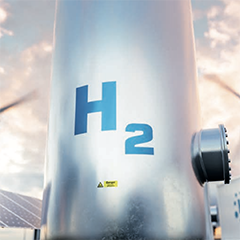In a recent statement, Fatih Birol, head of the International Energy Agency, affirmed his belief that in order to achieve the targets of the Paris Climate Agreement, global low carbon hydrogen production must reach 40 million tons annually by 2030, requiring an almost one hundredfold increase from today’s levels. The European Commission just announced its hydrogen strategy, which includes the ambitious goal of reaching an annual production capacity of one million tons of renewable hydrogen by 2024, and ten million tons by 2030. A new wind and hydrogen project in the Danish North Sea aims to become one of the world’s largest renewable hydrogen plants, featuring a standalone 1 GW of electrolyser capacity that will use electricity from wind turbines to produce hydrogen, with dedicated pipelines connecting it to industrial demand in Belgium and the Netherlands. Germany followed suit with plans to build up to 5 GW of electrolysis capacity. Several other solar-to-hydrogen demonstration projects are also underway.
These examples make it clear that hydrogen dominates public discourse and cutting-edge projects as the potential technology of the future. It promises to bridge the intermittency gaps of renewable energy generation and provide a clean and transportable energy carrier that can replace fossil fuels in combustion applications. Propelled by policymakers and industry alike, this promising solution to a
techno-economic problem has given rise to an entirely new energy economy subsector bearing its name: the hydrogen economy.
The operational principle of the hydrogen economy is this: at times when production exceeds demand, surplus energy is converted into hydrogen sourced from water through electrolysis, which can then either be used on the spot to generate electrical power or be transported over long distances to demand centres, without a loss of energy content. The benefits are many: a versatile energy carrier, hydrogen is carbon-free when burnt and emits only water vapour. It does not require a particular geographic contour to function, as pumped storage dammed hydroelectricity does. It can be stored over long periods and transported over long distances, unlike large battery storage. It can be used to produce other gases such as methane or ammonia, as well as liquid fuels.
It has a higher energy density on a volumetric basis as compared to batteries, making it suitable as a transport fuel.
Currently, hydrogen is produced on an industrial scale mainly through natural gas, with the output referred to as grey hydrogen. Though carbon-free when burnt, this is merely a case of transferring carbon emissions from the place of consumption to the place of production. Where carbon emissions from hydrogen production are captured and stored, the assigned
color-coding changes to blue, marking a more environmentally friendly version. A turquoise designation has been assigned to the products of pyrolysis where instead of CO2 the carbon residues are collected in solid form. If gained through nuclear-powered production, the output is interchangeably termed red, pink or purple. Hydrogen gained through renewables-powered production has, fittingly, been categorized as green.



























